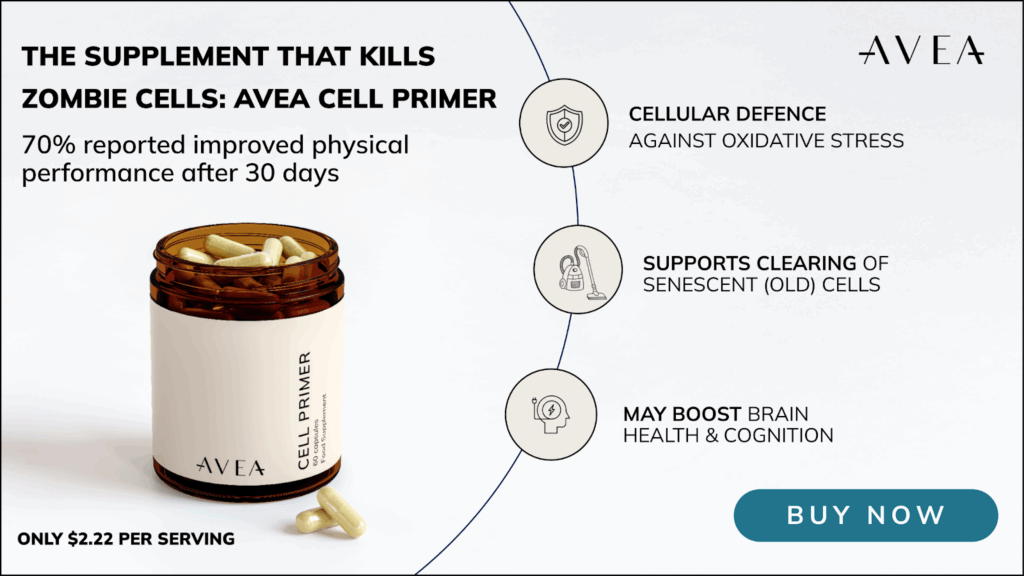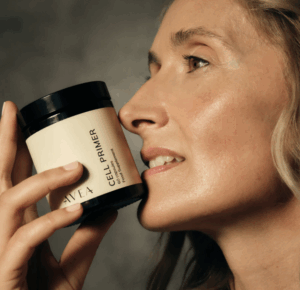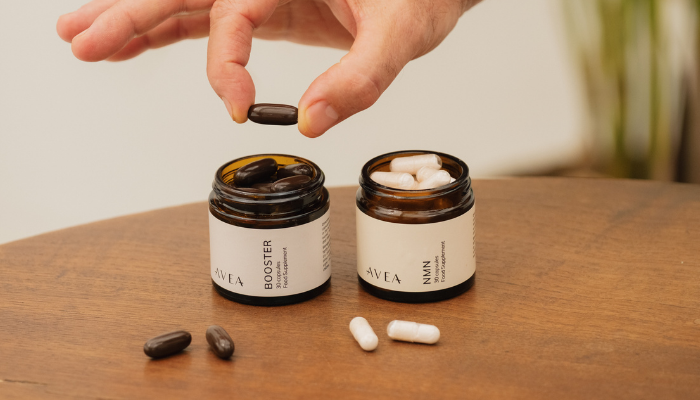In this article
Zombie Cells: The Cellular Saboteurs Ageing You from Within
Not all ageing is inevitable and not all cells are working in your favour. Inside your body right now are cells that no longer divide, no longer serve a function, and yet refuse to die. These are senescent cells, more popularly known as zombie cells. And like the zombies of pop culture, they wreak havoc on their surroundings.
While once a protective mechanism, these dormant-but-damaging cells accumulate with age and release toxic, inflammatory molecules that harm nearby healthy tissue. Over time, they fuel chronic inflammation, tissue degeneration, and many of the diseases we associate with ageing.
The good news? Science is now uncovering how to reduce these zombie cells—naturally and effectively.
What Are Zombie Cells (Senescent Cells) and Why Are They a Problem?
Zombie cells are damaged or stressed cells that permanently stop dividing. This process, called cellular senescence, is a natural mechanism to prevent defective cells from turning cancerous. In small amounts, senescent cells are helpful.
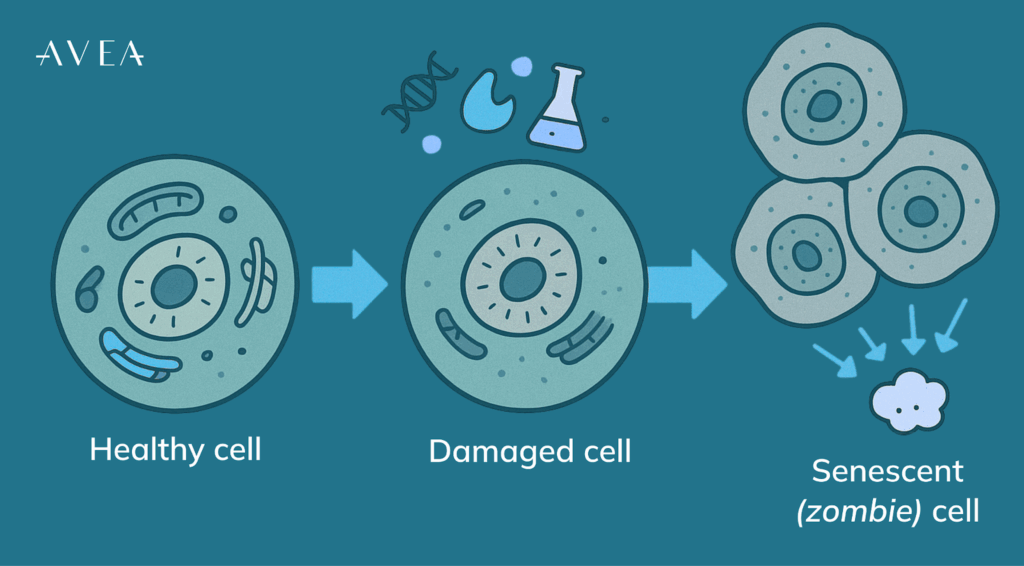
But with age or chronic stress, they begin to accumulate. Why?
- Increased production from DNA damage, oxidative stress, toxins, or inflammation
- Decreased clearance because the immune system weakens with age
Instead of dying off, these cells stick around and secrete harmful substances—a phenomenon known as the Senescence-Associated Secretory Phenotype (SASP). SASP includes inflammatory cytokines, proteases, and growth factors that:
- Damage surrounding cells
- Induce more cells into senescence
- Impair tissue repair
This creates a ripple effect of dysfunction across tissues and organs.
What Causes the Accumulation of Zombie Cells?
Your body relies on a delicate balance, known as homeostasis, to manage stress, repair tissues, and maintain overall health. As we age or face certain lifestyle and environmental challenges—this balance becomes harder to maintain. When homeostasis is disrupted, your body struggles to remove damaged cells, allowing zombie cells (senescent cells) to accumulate.
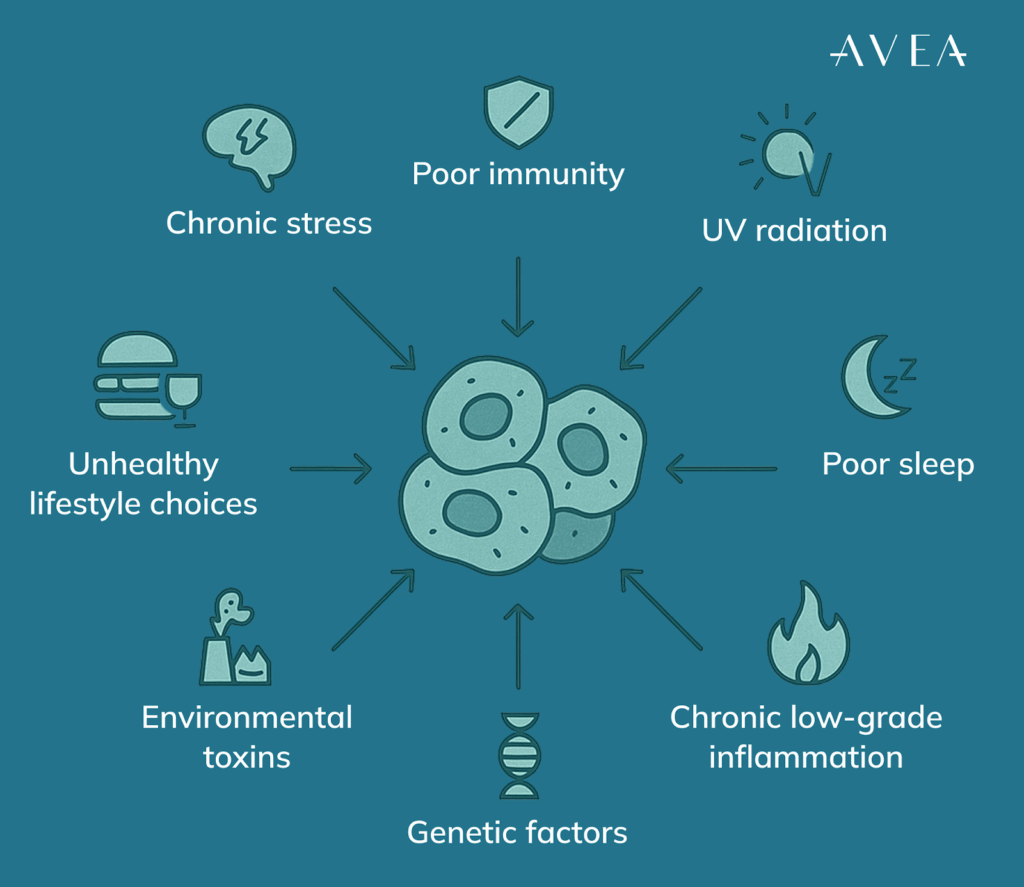
Several factors contribute to this build-up:
- Chronic Stress: Elevates cortisol, increases inflammation and oxidative stress, and impairs immune surveillance.
- Unhealthy Lifestyle Choices: Smoking, alcohol, poor diet, and inactivity weaken cellular repair systems and promote senescence.
- Environmental Toxins: Air pollution, industrial chemicals, and heavy metals damage DNA and impair detoxification systems.
- Chronic Low-Grade Inflammation: From obesity, poor diet, and unresolved infections.
- Genetic Factors: Family history of early ageing or autoimmune diseases can increase susceptibility.
- UV Radiation: Damages skin cells, triggering local senescence.
- Poor Sleep: Disrupts repair cycles, reduces NAD+ production, and weakens immunity.
How Harmful Are Zombie Cells?
Accumulated senescent cells are linked to:
- Cardiovascular issues (arterial stiffness, heart disease)
- Metabolic disorders (type 2 diabetes, obesity)
- Neurodegeneration (Alzheimer’s, Parkinson’s)
- Musculoskeletal problems (osteoporosis, arthritis)
- Liver and kidney dysfunction
- Lung damage (reduced respiratory function)
- Skin ageing (wrinkles, pigmentation)
- Cancers and acute conditions
Over time, these effects contribute to chronic inflammation, organ decline, and accelerated biological ageing.
The Importance of Senescent Cell Removal
Ageing does not have to mean inevitable decline. Scientific research suggests that targeting senescent cells can:
- Enhance organ function
- Alleviate inflammation and tissue damage
- Promote healthier ageing and extend healthspan
By reducing senescent cell burden, the body can restore balance, improve resilience, and potentially delay or prevent age-related diseases.
4 Evidence-Based Ways to Reduce Zombie Cells Naturally
1. Exercise
- Running (30–45 min, 3–4x/week): Supports cardiovascular health and reduces inflammation
- Swimming or aerobic movement: Encourages healthy mitochondrial function
- Light aerobic workouts (30 min, 5x/week): Improve resilience against cellular stress
Note: Overtraining may increase oxidative stress, so moderation is key.
2. Diet
- Avoid sugar, processed food, and unhealthy fats
- Adopt intermittent fasting or calorie restriction
- Embrace the Mediterranean diet: fruits, vegetables, legumes, healthy fats
- Blue Zones show the longevity benefits of a plant-rich, antioxidant-heavy diet
3. Gut Health
- Probiotics: yoghurt, kefir, kimchi, sauerkraut
- Prebiotics: garlic, leeks, oats, apples
- Microbiome diversity supports inflammation control and immune surveillance
4. Sleep
- Deep sleep supports tissue repair and healthy immune function
- Prioritise consistent sleep cycles (7–9 hrs)
- Support NAD+ and melatonin production through regular circadian rhythms
How to Remove Senescent Cells: Senolytics and Senomorphics
What Are Senolytics?
Senolytics are compounds or drugs that eliminate senescent cells by disrupting their survival mechanisms.
Natural senolytics examples are:
- Quercetin: A flavonoid found in fruits and vegetables; breaks down senescent cell defences
- Fisetin: A polyphenol from strawberries and apples; supports cellular health and resilience
Both are being studied in clinical settings and show exciting promise as part of holistic longevity strategies.
What Are Senomorphics?
Senomorphics don’t destroy senescent cells. Instead, they suppress the harmful SASP without eliminating the cell entirely.
Natural Senomorphics examples:
- Curcumin: From turmeric; reduces inflammatory cytokines and oxidative stress
- EGCG: From green tea; supports cellular metabolism and immune balance
- Resveratrol: Modulates inflammatory and metabolic ageing pathways
- Apigenin: Found in parsley and chamomile; supports antioxidant defence
Pharmaceutical/Experimental Senomorphics:
- Metformin: Known for its anti-inflammatory and metabolic benefits
- Rapamycin: Investigated for its potential in ageing and autophagy enhancement
- JAK inhibitors (e.g. Ruxolitinib): Target pro-inflammatory pathways
Using senolytics to remove harmful cells and senomorphics to reduce their impact offers a dual approach to healthy ageing.
Supplements to Remove Zombie Cells: The AVEA Cell Primer
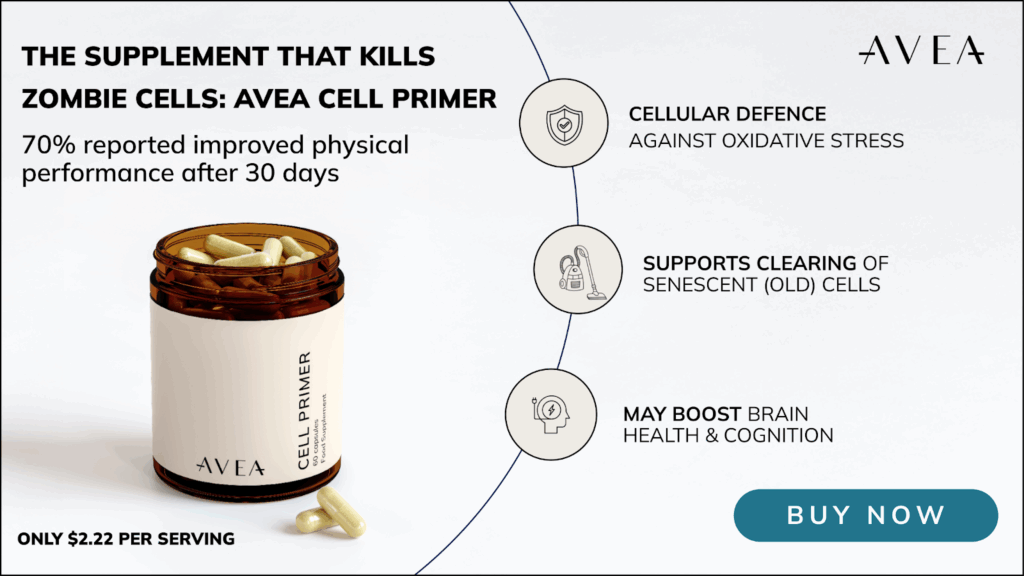
AVEA Cell Primer is a scientifically formulated supplement designed to:
- Eliminate harmful senescent cells
- Support mitochondrial function and energy
- Enhance autophagy and antioxidant defence
Here’s how each ingredient supports cellular health:
1. Targets Zombie Cells with Senolytics
- Quercetin (500 mg): Supports senescent cell clearance and reduces inflammation
- Fisetin (125 mg): Promotes cellular rejuvenation and healthy tissue function
2. Boosts Cellular Energy
- PQQ: Enhances mitochondrial function, boosts ATP production, and supports cognitive health
3. Protects Against Oxidative Stress
- Ergothioneine (5 mg): A rare antioxidant found in mushrooms, especially oyster and shiitake varieties. You’d need to eat over 100g of cooked mushrooms to obtain a similar dose.
- Selenium (100 µg): Supports immune function and antioxidant enzymes
4. Stimulates Cellular Renewal
- Spermidine: Promotes autophagy, helping your body clear out cellular debris and regenerate
Benefits of Taking AVEA Cell Primer
- More energy and less fatigue
- Better focus and mental clarity
- Reduced systemic inflammation
- Enhanced recovery and resilience
- Long-term support for healthy ageing
By combining senolytics and antioxidants, the Cell Primer equips your body to eliminate zombie cells and thrive.
Final Thought: Support Longevity from the Inside Out
Zombie cells accelerate ageing, but with lifestyle change, targeted nutrition, and advanced supplements like AVEA Cell Primer, you can slow down biological ageing, boost performance, and protect your long-term health.
Because longevity starts at the cellular level—and you have the tools to take control.
